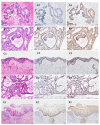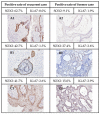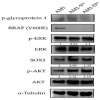Enrichment of SOX2-Positive Cells in BRAF V600E Mutated and Recurrent Ameloblastoma
- PMID: 35055392
- PMCID: PMC8780877
- DOI: 10.3390/jpm12010077
Enrichment of SOX2-Positive Cells in BRAF V600E Mutated and Recurrent Ameloblastoma
Abstract
Ameloblastoma is the most common benign odontogenic neoplasm, but with an aggressive behavior and a high recurrence rate. Nowadays wide surgical resection is the current recommended treatment, which can cause further loss of function and esthetics. Recent studies point to the stem/progenitor cells as both initiators and propagators of the tumors. Elucidation of the cellular and molecular mechanisms underlying the tumor stem cells is of broad interest for understanding tumorigenesis and for developing effective targeted therapies. SRY related HMG box gene 2 (SOX2) is a transcription factor that plays important roles in development, stem cell renewal, and cancer formation. Few studies have revealed increased SOX2 expression in atypical ameloblastoma and ameloblastic carcinoma. For the development of personalized medicine for ameloblastoma, biomarkers that provide prognostic or predictive information regarding a tumor's nature or its response to treatment are essential. Thus, in this study, we aimed to study if SOX2-positive cells exist in ameloblastomas and their correlation with the clinicopathologic parameters. Our data suggested BRAF(V600E) mutation might contribute to the expansion of SOX2-positive cells. The identification of BRAF(V600E) mutation and the amplification of SOX2-positive cells in ameloblastomas imply the possible benefit of applying BRAF and SOX2 inhibitors in recurrent and un-resectable ameloblastomas.
Keywords: BRAF V600E; SOX2; ameloblastoma; recurrence; stem cells.
Conflict of interest statement
The authors declare no conflict of interest.
Figures









References
-
- El-Naggar A.K., Chan J.K.C., Grandis J.R., Takata T., Slootweg P.J. WHO Classification of Head and Neck Tumours. 4th ed. International Agency for Research on Cancer; Lyon, France: 2017. pp. 215–218.
-
- Neville B.W., Damm D.D., Allen C.M., Chi A.C. Oral and Maxillofacial Pathology. 4th ed. Elsevier; St. Louis, MO, USA: 2016. pp. 653–661.
Grants and funding
LinkOut - more resources
Full Text Sources
Research Materials

